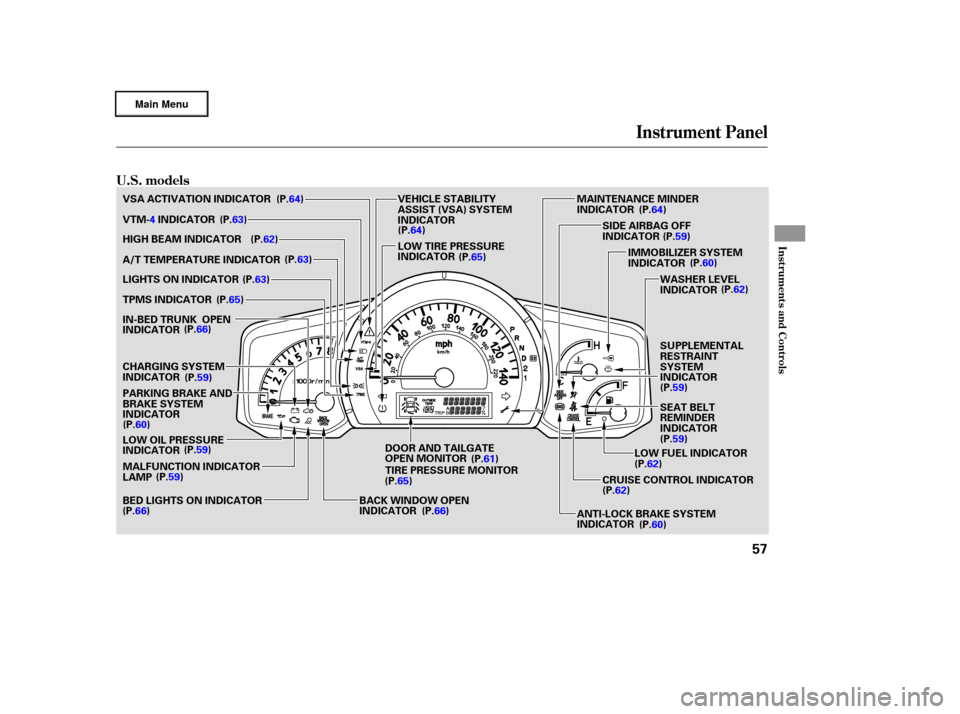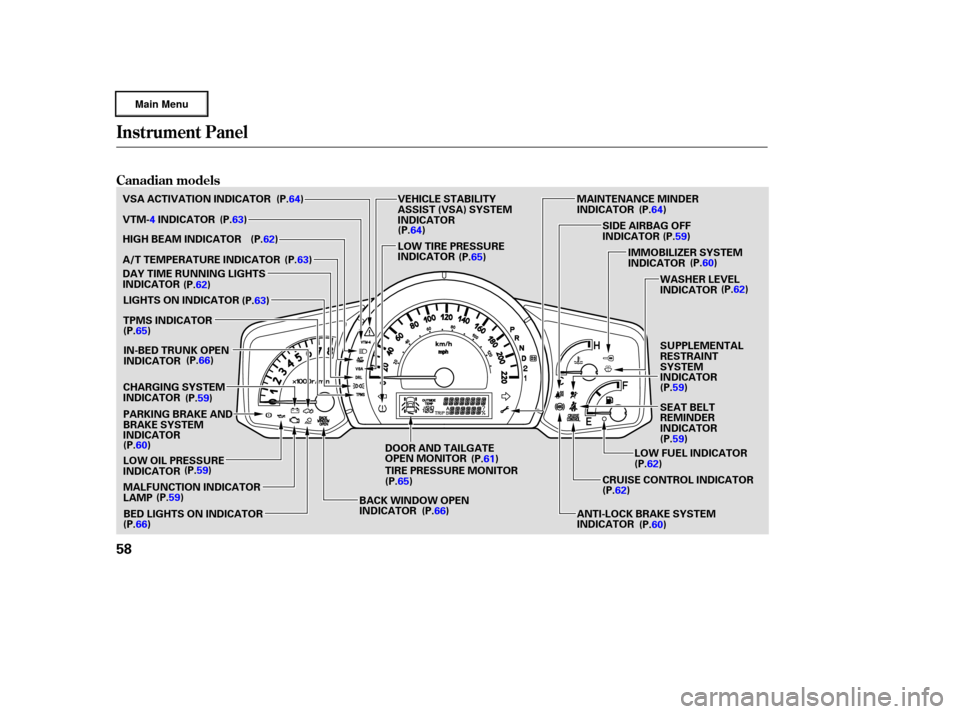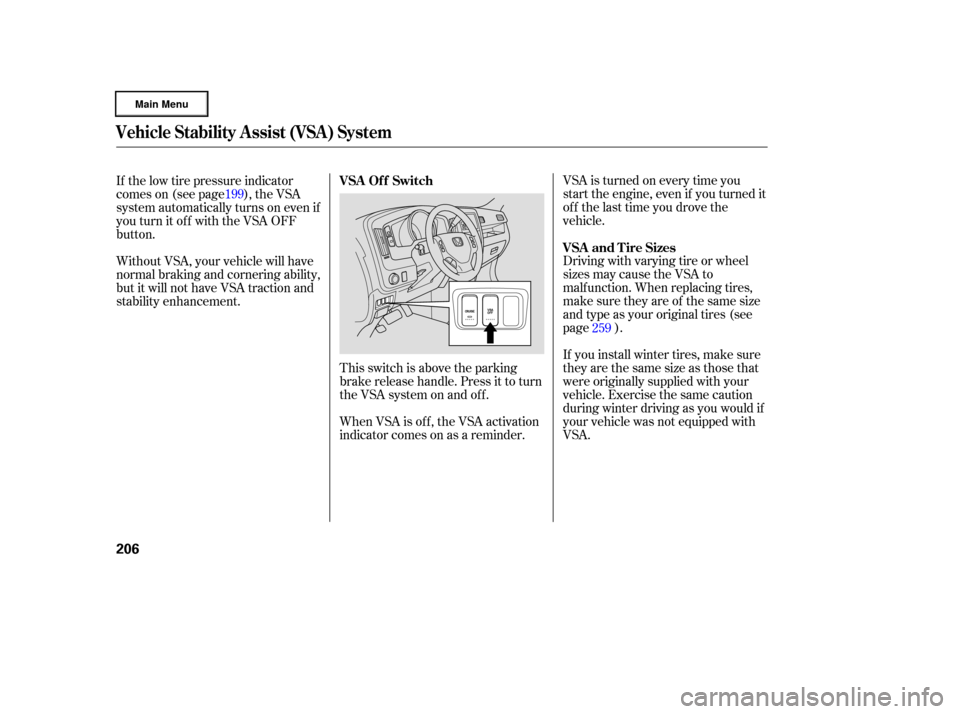Page 60 of 320

Instrument Panel
Inst rument s and Cont rols
U.S. models
57
IMMOBILIZER SYSTEM
INDICATORWASHER LEVEL
INDICATOR
MALFUNCTION INDICATOR
LAMP LOW OIL PRESSURE
INDICATOR VSA ACTIVATION INDICATOR
VTM-4INDICATOR
HIGH BEAM INDICATOR
A/T TEMPERATURE INDICATOR
LIGHTS ON INDICATOR
TPMS INDICATOR
CHARGING SYSTEM
INDICATOR
PARKING BRAKE AND
BRAKE SYSTEM
INDICATOR SIDE AIRBAG OFF
INDICATOR
LOW FUEL INDICATOR
CRUISE CONTROL INDICATOR
DOOR AND TAILGATE
OPEN MONITOR
BACK WINDOW OPEN
INDICATOR LOW TIRE PRESSURE
INDICATOR
MAINTENANCE MINDER
INDICATOR
ANTI-LOCK BRAKE SYSTEM
INDICATOR
VEHICLE STABILITY
ASSIST (VSA) SYSTEM
INDICATOR
SUPPLEMENTAL
RESTRAINT
SYSTEM
INDICATOR
SEAT BELT
REMINDER
INDICATOR
BED LIGHTS ON INDICATOR (P.64)
(P.63) (P.62)
(P.63)
(P.63)
(P.65)
(P.66)
(P.59)
(P.60) (P.59)
(P.59)
(P.66) (P.64)
(P.65) (P.64)
(P.59) (P.60)
(P.62)
(P.59)
(P.59)
(P.62)
(P.62)
(P.60)
TIRE PRESSURE MONITOR
(P.65) (P.61)
(P.66)
IN-BED TRUNK OPEN
INDICATOR
�����—�
���—�����y�
�������������y���
�(�����������y���������y
Page 61 of 320

Instrument Panel
Canadian models
58
IMMOBILIZER SYSTEM
INDICATORWASHER LEVEL
INDICATOR
MALFUNCTION INDICATOR
LAMP LOW OIL PRESSURE
INDICATOR
VSA ACTIVATION INDICATOR
VTM-4INDICATOR
HIGH BEAM INDICATOR
A/T TEMPERATURE INDICATOR
LIGHTS ON INDICATOR
TPMS INDICATOR
CHARGING SYSTEM
INDICATOR
PARKING BRAKE AND
BRAKE SYSTEM
INDICATOR SIDE AIRBAG OFF
INDICATOR
LOW FUEL INDICATOR
CRUISE CONTROL INDICATOR
DOOR AND TAILGATE
OPEN MONITOR
BACK WINDOW OPEN
INDICATOR LOW TIRE PRESSURE
INDICATOR
MAINTENANCE MINDER
INDICATOR
ANTI-LOCK BRAKE SYSTEM
INDICATOR
VEHICLE STABILITY
ASSIST (VSA) SYSTEM
INDICATOR
SUPPLEMENTAL
RESTRAINT
SYSTEM
INDICATOR
SEAT BELT
REMINDER
INDICATOR
DAY TIME RUNNING LIGHTS
INDICATOR
BED LIGHTS ON INDICATOR TIRE PRESSURE MONITOR
(P.64)
(P.63) (P.62)
(P.63)
(P.62) (P.63)
(P.65) (P.66)
(P.59)
(P.60) (P.59)
(P.59)
(P.66) (P.64)
(P.65) (P.64)
(P.59) (P.60)
(P.62)
(P.59)
(P.59)
(P.62)
(P.62)
(P.60)
(P.61)
(P.65)
(P.66)
IN-BED TRUNK OPEN
INDICATOR
�����—�
���—�����y�
�������������y���
�(�����������y���������y
Page 192 of 320

This section gives you tips on
starting the engine under various
conditions, and how to operate the
automatic transmission. It also
includes important inf ormation on
parking your vehicle, the braking
system, the VTM-4system, the VSA
system, the tire pressure monitoring
system, and f acts you need if you are
planning to tow a trailer.........................
Driving Guidelines .190
........................
Preparing to Drive .191
.......................
Starting the Engine .192
..............
Automatic Transmission .193
Variable Torque Management
.........
4WD (VTM-4) System .198
..............................
VTM-4Lock .198
Tire Pressure Monitoring System ......................................
(TPMS) .199
...........................................
Parking .201
.............................
Braking System .202
...............
Anti-lock Brakes (ABS) .203
Vehicle Stability Assist (VSA)
........................................
System .205
.................
Towing Weight Limits .207
..........
Towing Weight Guidelines .209
...........................
Towing a Trailer .210
Of f -Highway Driving
..................................
Guidelines .219
Driving
Driving
189
�����—���
�—�����y�
�������������y���
�(�����������y���
�����y
Page 205 of 320

If the brake pads need replacing, you
will hear a distinctive, metallic
screeching sound when you apply
the brake pedal. If you do not have
the brake pads replaced, they will
screech all the time. It is normal f or
the brakes to occasionally squeal or
squeak when you apply them. Check the brakes after driving
through deep water. Apply the
brakes moderately to see if they f eel
normal. If not, apply them gently and
f requently until they do. Be extra
cautious in your driving.
The hydraulic system that operates
the brakes has two separate circuits.
Each circuit works diagonally across
the vehicle (the lef t-f ront brake is
connected with the right-rear brake,
etc.). If one circuit should develop a
problem, you will still have braking
at two wheels.
Your vehicle is equipped with disc
brakes at all f our wheels. A power
assist helps reduce the ef f ort needed
on the brake pedal. The anti-lock
brake system (ABS) helps you retain
steering control when braking very
hard.
Resting your f oot on the pedal keeps
the brakes applied lightly, builds up
heat, increases wear, and reduces
their ef f ectiveness. It also keeps
your brake lights on all the time,
conf using drivers behind you.
Constant application of the brakes
when going down a long hill builds
up heat and reduces their ef f ective-
ness. Use the engine to assist the
brakes by taking your f oot of f the
accelerator and downshif ting to a
lower gear.
If the vehicle is f acing uphill, turn
the front wheels away from the
curb, and set the parking brake.
If the vehicle is f acing downhill,
turn the front wheels toward the
curb, and set the parking brake.
Make sure the parking brake is
f ully released bef ore driving away.
Driving with the parking brake
partially set can overheat or
damage the parking brake.
Brake Wear Indicators Braking System Design
Braking System
Parking, Braking System
202
�����—�����—�����y�
����
��������y���
�(�����������y���������y
Page 209 of 320

VSA is turned on every time you
start the engine, even if you turned it
off the last time you drove the
vehicle.
Driving with varying tire or wheel
sizes may cause the VSA to
malf unction. When replacing tires,
make sure they are of the same size
and type as your original tires (see
page ).
When VSA is off, the VSA activation
indicator comes on as a reminder. If you install winter tires, make sure
they are the same size as those that
were originally supplied with your
vehicle. Exercise the same caution
during winter driving as you would if
your vehicle was not equipped with
VSA.
This switch is above the parking
brake release handle. Press it to turn
the VSA system on and of f .
If the low tire pressure indicator
comes on (see page ), the VSA
system automatically turns on even if
youturnitoff withtheVSAOFF
button.
Without VSA, your vehicle will have
normal braking and cornering ability,
but it will not have VSA traction and
stability enhancement.
259
199
VSA Of f Switch
VSA and Tire Sizes
Vehicle Stability Assist (VSA) System
206
�����—�
���—�����y�
�������������y���
�(�����������y�����
�
�y